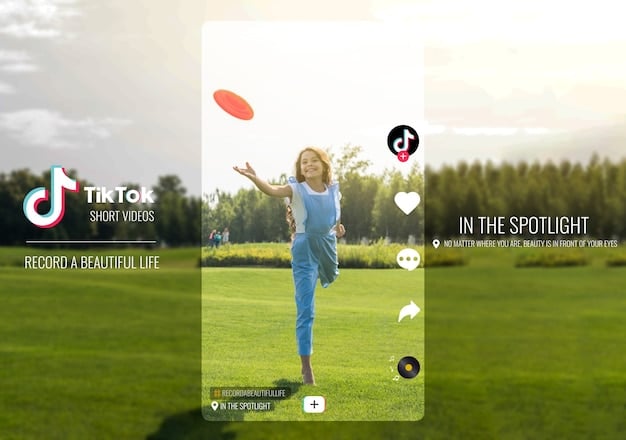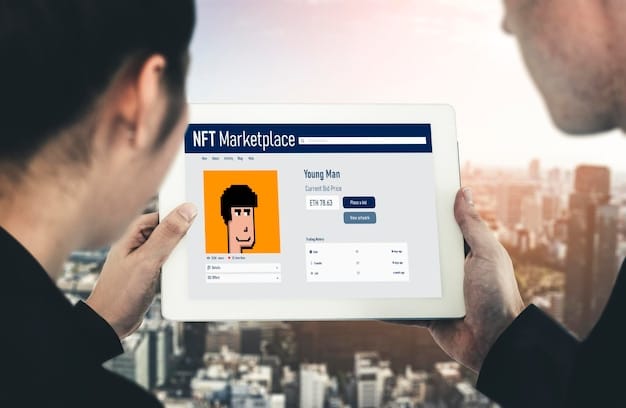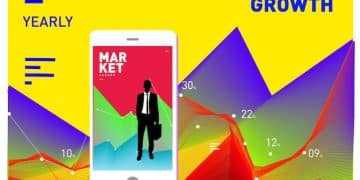Paid Social Media Advertising in 2025: Maximizing Your ROI

Paid social media advertising in 2025 necessitates a strategic approach to platform selection, focusing on audience alignment, innovative ad formats, and robust analytics to ensure the best return on investment (ROI) across platforms like TikTok, Instagram, Facebook, and LinkedIn.
Navigating the world of paid social media advertising in 2025: which platform offers the best ROI? requires a keen understanding of evolving trends and user behavior. Let’s delve into the strategies that will shape successful campaigns.
Understanding the Evolving Landscape of Paid Social Media
The realm of paid social media is constantly shifting, with new features, algorithms, and user behaviors emerging regularly. To achieve a strong ROI in 2025, marketers need to stay ahead of these changes.
Understanding these changes and how they impact advertising strategies is crucial.
Key Trends Shaping Social Media Advertising in 2025
Several trends are set to define the landscape of paid social media in the coming years.
- AI-Powered Advertising: AI will play an even bigger role in targeting, ad creation, and optimization.
- Augmented Reality Ads: AR experiences will become more prevalent, offering immersive ways to engage users.
- Short-Form Video Dominance: Platforms like TikTok and Instagram Reels will continue to drive engagement through short, captivating videos.
- Privacy-Focused Advertising: With growing privacy concerns, advertisers will need to adopt strategies that respect user data while delivering personalized experiences.
These trends will not only change how ads are created but also how they are targeted and measured.
TikTok: A Powerhouse for Gen Z and Beyond
TikTok’s explosive growth has made it an invaluable platform for reaching younger audiences. Its unique algorithm and focus on short-form video content provide distinctive advertising opportunities.
But how can advertisers maximize their ROI on this platform?
Advertising Strategies on TikTok
TikTok offers various ad formats, each with its own strengths.
- In-Feed Ads: These appear natively in the user’s “For You” feed and can drive significant engagement.
- Brand Takeovers: These are full-screen ads that appear when a user first opens the app, providing maximum visibility.
- Branded Hashtag Challenges: These encourage user-generated content and can create viral buzz around a brand.
Success on TikTok requires a deep understanding of the platform’s culture and trends. Ads that feel authentic and engaging are more likely to resonate with users.

Instagram: Visual Storytelling and Influencer Marketing
Instagram remains a powerhouse for visual storytelling and influencer marketing. Its diverse user base and focus on high-quality imagery make it an ideal platform for brands seeking to build a strong visual identity.
Let’s explore how to leverage Instagram for optimal ad performance.
Maximizing ROI on Instagram
Instagram provides a range of ad formats and targeting options.
- Story Ads: These immersive ads appear between user stories and can include interactive elements like polls and quizzes.
- Feed Ads: These ads appear in the user’s main feed and can be highly targeted based on interests and demographics.
- Reels Ads: Similar to TikTok, Reels ads offer a dynamic way to reach users through short-form video content.
- Influencer Marketing: Collaborating with influencers remains a powerful strategy for reaching niche audiences and building trust.
Using high-quality visuals and compelling storytelling is essential for capturing attention on Instagram. Understanding the platform’s aesthetic and aligning your ads with user expectations is key.
Facebook: A Versatile Platform with Extensive Targeting Capabilities
Despite the rise of newer platforms, Facebook remains a dominant force in social media advertising. Its massive user base and advanced targeting capabilities make it a versatile option for reaching a wide range of audiences.
But how can advertisers cut through the noise and achieve a strong ROI on Facebook?
Facebook Advertising Strategies for 2025
Facebook offers a variety of ad formats and targeting options.
Facebook’s advantages include:
- Detailed Targeting: Facebook’s extensive data allows for precise targeting based on demographics, interests, behaviors, and more.
- Diverse Ad Formats: From image and video ads to carousel and collection ads, Facebook offers a range of options to suit different marketing goals.
- Retargeting: Facebook’s retargeting capabilities enable advertisers to reach users who have previously interacted with their website or app.
Creating personalized ad experiences and leveraging Facebook’s advanced targeting features can help advertisers drive conversions and maximize their ROI.
LinkedIn: Targeting Professionals and B2B Audiences
LinkedIn is the premier platform for reaching professionals and B2B audiences. Its focus on career development and networking makes it an ideal channel for brands targeting specific industries or job titles.
Developing a successful LinkedIn advertising strategy requires an understanding of the platform’s unique audience and purpose.

Strategies for Effective LinkedIn Advertising
LinkedIn offers several ad formats tailored to professional audiences.
- Sponsored Content: These ads appear directly in the user’s feed and can be highly targeted based on job title, industry, and company size.
- Sponsored InMail: These personalized messages are sent directly to users’ inboxes and can be an effective way to reach key decision-makers.
- Text Ads: These small, text-based ads appear on the side of the page and can be a cost-effective option for driving traffic to your website.
Crafting compelling ad copy that speaks to the needs and interests of professionals is crucial for success on LinkedIn. Showcasing expertise and providing valuable insights can help build trust and generate leads.
Measuring ROI: Key Metrics and Analytics
Measuring the ROI of your paid social media campaigns is essential for understanding what’s working and what’s not. By tracking key metrics and analyzing your results, you can optimize your campaigns for maximum performance.
What are the most important metrics to track in 2025?
Essential Metrics for Tracking ROI
Several metrics can provide valuable insights into the performance of your paid social media campaigns.
Metrics to consider include:
- Click-Through Rate (CTR): This measures the percentage of users who click on your ad after seeing it.
- Conversion Rate: This measures the percentage of users who complete a desired action, such as making a purchase or filling out a form.
- Cost Per Acquisition (CPA): This measures the cost of acquiring a new customer through your paid social media campaigns.
- Return on Ad Spend (ROAS): This measures the revenue generated for every dollar spent on advertising.
Using analytics tools to track these metrics and analyze your results can help you identify areas for improvement and optimize your campaigns for maximum ROI.
Adapting to Privacy Changes and Data Regulations
With growing concerns about data privacy, social media platforms are implementing stricter regulations and privacy features. Advertisers need to adapt their strategies to comply with these changes while still delivering personalized experiences.
How can advertisers navigate this evolving landscape?
Strategies for Privacy-Focused Advertising
Several strategies can help advertisers navigate the changing privacy landscape.
- First-Party Data: Focus on collecting and leveraging first-party data, which is data that you collect directly from your customers.
- Contextual Advertising: Target users based on the content they are viewing, rather than their personal data.
- Transparency and Consent: Be transparent about how you are collecting and using user data and obtain explicit consent whenever possible.
Prioritizing user privacy and building trust can help advertisers maintain strong relationships with their customers while still achieving their marketing goals.
| Key Point | Brief Description |
|---|---|
| 🚀 TikTok’s Potential | Best for reaching Gen Z with engaging short-form video content. |
| 📸 Instagram’s Strategy | Ideal for visual storytelling, influencer marketing, and high-quality imagery. |
| 🎯 Facebook’s Targeting | Offers extensive targeting capabilities, diverse ad formats, and retargeting. |
| 💼 LinkedIn for B2B | Best for reaching professionals with sponsored content and personalized messaging. |
Frequently Asked Questions
▼
Instagram is frequently cited as delivering a strong ROI for e-commerce, particularly through features like shoppable posts and product stickers in stories, which directly link to product pages.
▼
AI is improving ad targeting accuracy, personalizing ad content, and automating campaign optimization, allowing marketers to achieve better results with less hands-on management.
▼
Increased privacy regulations are pushing advertisers to rely more on first-party data and contextual advertising to reach their audiences, which may reduce the precision of targeting but enhances consumer trust.
▼
Emerging ad formats include short-form video ads (like TikTok’s) and interactive ads that incorporate AR/VR elements, creating more engaging and immersive experiences for users.
▼
Mobile optimization remains critically important as the vast majority of social media users access platforms via mobile devices. Ads must be designed to load quickly and display correctly on smaller screens.
Conclusion
As we look to 2025, the landscape of paid social media advertising will continue to evolve, presenting new challenges and opportunities for marketers. By staying informed of emerging trends, embracing innovative strategies, and prioritizing user privacy, advertisers can drive meaningful engagement and achieve a strong ROI across various social media platforms.





